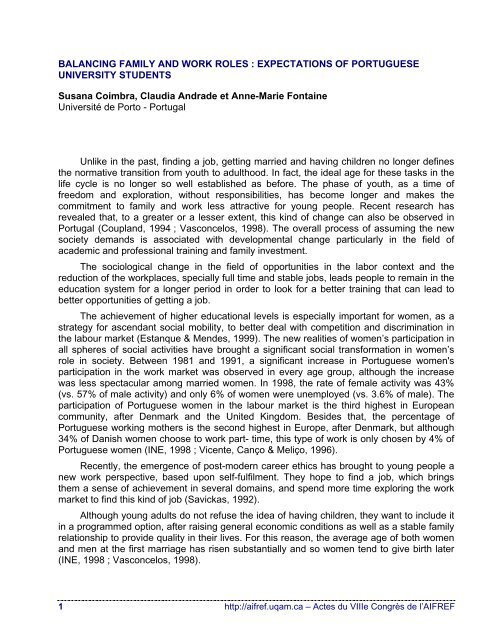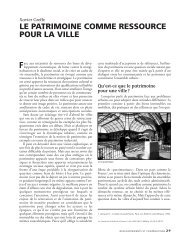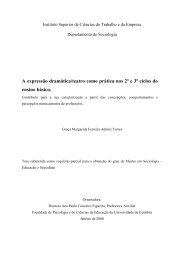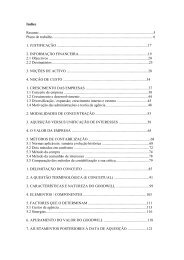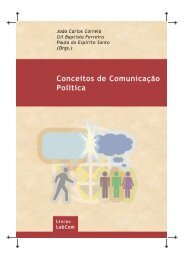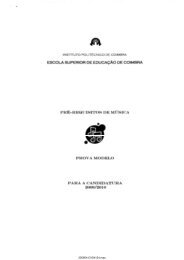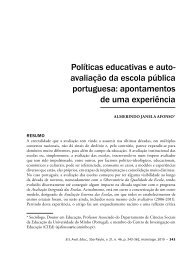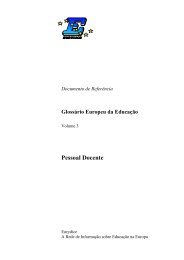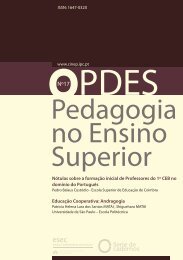BALANCING FAMILY AND WORK ROLES : EXPECTATIONS OF ...
BALANCING FAMILY AND WORK ROLES : EXPECTATIONS OF ...
BALANCING FAMILY AND WORK ROLES : EXPECTATIONS OF ...
Create successful ePaper yourself
Turn your PDF publications into a flip-book with our unique Google optimized e-Paper software.
This framework implies a longer economic support from parents, contributing to thedelay of entrance into adulthood, and keeps young adults away from the responsibility ofachieving their own independence from the family. Psychological autonomy increases withage and seem to have a positive impact on psychological well being and in the adaptation toother life contexts. However, the psychological separation process depends upon somevariables such as family dynamics and gender.Traditionally, parents tend to stimulate boys’ levels of autonomy and establish strongerbarriers to the development of girls’ autonomy, through over-protection. When a democraticeducational style is provided, girls tend to benefit more than boys, being encouraged toreach higher levels of autonomy and self-confidence. The achievement of autonomy, from amore complex perspective, is still strongly influenced by the social stereotypes related withmasculine and feminine roles (Fontaine, 1990). Nowadays, because young people leave thefamily later, the longer parental support makes their access to autonomy more difficult, bothin funcional and emotional terms. In this climate of dependence, the interpersonal conflictswith parents will also be viewed as less natural and more threatening. Previous studies haveshown that females are expected to be more sensitive to relational problematic (Almeida etal. 1996).However, traditional education trains girls well to care about themselves and others.For this reason, they are expected to see themselves as more nurturing, and morecompetent in intimate relationships than males as well as better manager of the householddomain. In general terms, females are expected to be more autonomous than males infunctional aspects but less autonomous in emotional and conflictual ones.In gender-stereotyped cultures, like the Portuguese, in spite of the emergence of newvalues in the sphere of professional work, conservative values are still largely transmittedand internalised by both men and women. Those values are the reference for women’s selfevaluationas workers, spouses, housekeepers, and mothers (Andrade & Fontaine, 2000).We can assume that, nowadays, working outside the home is a social value inPortugal, which is almost unquestionable for both genders. However, young women still donot want to reject the traditional view, maintaining the primary responsibility for home andchildcare (Andrade & Fontaine, 2000). According to this perspective, women, more thanmen, are expected to balance their professional duties with family roles. The change of thesocial perspective about work and family roles seems to have more influence on women’slife than on men’s. The difficulty in supporting the burden associated with this change maylead young women to question sex roles, to explore different perspectives about socialnorms and values and, therefore, to develop their own representations about social values,attitudes and beliefs, which may be different from those of their parents. So, females areexpected to be more autonomous in ideological terms than males. From the sameperspective, students who do not share dominant social values are probably moreindependent ideologically from their parents than the more conformist students. Thecoexistence of new and old women’s professional and family roles also implies the use ofstrategies to cope with the demand of both fields, integrated in a complex decision makingprocess of establishment of life priorities. The traditional view of family is implicitly assumedby public policies.http://aifref.uqam.ca – Actes du VIIIe Congrès de l’AIFREF 2
Indeed, Portugal in comparison with other European countries has the lowest level ofpublic equipment for childcare and domestic support. At home, Portuguese women areresponsible for most of the domestic affairs and the more demanding ones.In fact, nowadays, women are still educated in ambivalence : during the school years,they are asked to compete and prepare themselves for a more competitive work market,but, as they approach adulthood, they are also asked to moderate or renounce those valuesand assume other home and family oriented values which are more recognized by thesociety. Recent Portuguese studies have found that almost all young adults are in favor ofequality between men and women, but agree that women should be more involved indomestic tasks such as taking care of children. Their opinion about feminine specializationin reproductive tasks is clear and very traditional, as they revealed that women should givemore importance to her family role than to her professional career (Amâncio, 1994 ;Bardwick & Douvan, 1990 ; Inglez, 1996 ; Vasconcelos, 1998). From a very traditionalperspective, men will be more concerned with their own career, professional mastery andinvolvement than with the career of their partner, while the opposite is expected for womenwho value more highly family and conjugality. The self-perception of professionalcompetence and capability to be an adequate provider for the family is expected to be moreimportant for men than women.Thus the balance of family/domestic and professional/work roles remains asymmetricalfor men and women. The work and home spheres are sequential for men and simultaneousand permeable for women. It is known that a housewife’s time is continuous, without anydifferences between work and leisure, between working days and weekends or holidaysreferences. No difference is expected for the working female graduates but the duplicationof the demands (Inglez, 1996 ; Pleck in Duxbury & Higgins, 1991).Faced with such a social transformation, the construction of gender role by women ismore complex and three kinds of scenario have been identified in previous research(Amâncio, 1994 ; Costa, 1991).A minority of women, from a counter-normative perspective shares the first scenario,which was dominant in previous generations. In this scenario, women assume the« traditional » values of marriage and family and some young women discouraged by theirmothers’ double burden in the work and family context will assume a different pattern fortheir own lives. Their claims of independence and equality are based on their right to bedifferent and to reject the exclusive value of professional work. However, most women feeldiscouraged by the lack of social recognition of the value of family and marriage. Some ofthem react by assuming an image based exclusively on work competence, while othersassume the double role in family and work.The second scenario invokes the need of women to achieve their own independencethrough investment and success, especially in the work field. The main conception of thisrepresentation for women is considered closer to that of men involving characteristics suchas autonomy, activity, competition, and a greater need of achievement, which implies rights,privilege and a new identity for women. These women usually do not give much value tofamily and marriage projects and, when they assume these projects, they do it later in theirlife.3 http://aifref.uqam.ca – Actes du VIIIe Congrès de l’AIFREF
The involvement in both family and work duties challenges the need to be competent inboth areas, characterises the third and last scenario. In practice, women consider these twodimensions essential for the construction of their identity.We can see that the choice of life scenarios is becoming a challenge for young adults.In Portugal, striking a balance between family and work duties seems to be the rule for themajority of women but not for men, who invest almost exclusively in professional duties.This difference in social demands will be associated with the development of differentpsychological characteristics in males and females.It is expected that men and women will develop different forms of fixing priorities anddistributing their time (thinking styles), according to the number and importance of their lifeaims. As women need to establish priorities among the tasks to be done in the two lifecontexts, according to their order of importance and/or urgency, they tend to use mostly ahierarchical thinking style. It would be also the case of people who valued work and familyroles and responsibilities equally. This need of priority is absent in the monarchic, oroligarchic thinking styles, which, therefore, are more expected in men or people who valuework roles exclusively. In fact, monarchical people will concentrate their efforts on a singleaim that mobilizes all their energy and attention (e.g. work). The oligarchic people avoidestablishing priorities among aims, which is only possible when people have a limitednumber of aims that mobilize their energy. Finally, the anarchic people perform the tasks tobe done, as they appear, apparently adopting unusual or casual way of approaching tasks(Sternberg, 1997). As this style is difficult to maintain in modern societies, it is expected thatonly people who don’t value either work or family will manifest it.1. AIMSThe aim of our study is to observe gender differences among a sample of Portugueseuniversity students, as well as differences according the relative importance attributed tomarriage/conjugality and work/employment, on several psychological dimensions relatedwith balancing family and work : autonomy (functional, conflictual, ideological andemotional) levels, forms of thinking styles (hierarchic, monarchic, oligarchic and anarchic),work and family orientation (competition, work, employment, mastery, indifference towardspeers, partner’s career status) and self-perceptions on areas related to family and work(adequate provider, job competence, nurturing, household manager, global self-worth).http://aifref.uqam.ca – Actes du VIIIe Congrès de l’AIFREF 4
1.1Autonomy DimensionsFunctionalIdeologicalConflictualEmotionalGenderMale/Female2.11.22.2Thinking StylesOligarchicMonarchicAnarchicHierarchic3.13.2Orientation toward Work and FamilyMastery ; WorkCompetition ; EmploymentEffort ; Indifference toward peersPartner’s Employment StatusImportanceAttributed toMarriage/conjugalityand Work/employment4.14.2Adult Self-PerceptionsJob Competence ; Nurturance ; Adequacyas a Provider ; Household Management ;Intimate Relationships ;Global Self-worthGraph 1. Aims and hypotheses2. HYPOTHESIS2.1 Expected differences in the autonomy dimensions :a) Female university students are more ideologically and functionally independent, andless conflictually and emotionally independent of their parents, than male universitystudents.5 http://aifref.uqam.ca – Actes du VIIIe Congrès de l’AIFREF
) University students who place more value on work/employment than onconjugality/marriage will be less ideologically, emotionally, conflictually and functionallyindependent than those who value more highly conjugality/marriage.2.2 Expected differences in thinking styles dimensions :a) Male students will be more oligarchic and monarchic and less hierarchic than femalestudents. No gender differences are expected on anarchic thinking style.b) University students who value most highly work or marriage will be more oligarchic,monarchic and perhaps also more anarchic, but less hierarchic than students who valueboth work and conjugality/marriage.2.3 Expected differences in work and family orientation dimensions :a) Male students will be more oriented toward work, competition, mastery,employment, and effort and less oriented toward partner career and more indifferent towardpeers than female students.b) Students who value work/employment more will be more oriented toward work,competition, mastery, employment, and effort and less oriented toward partner career thanstudents who place a higher value on marriage/conjugality.2.4 Expected differences in the adult self-perception dimensions :a) In comparison to male students, female university students will foresee themselvesas more nurturing, ready for intimate relationships and as household managers than theirmale counterpart ; no gender differences are expected in job competence, adequateprovider and global self-worth perceptions.b) Students who value work/employment more will perceive themselves more asadequate providers and competent workers and less as nurturous, household managers,and ready for intimate relationship than the students who value more highlymarriage/conjugality. No differences are expected on global self-worth.3. METHODS3.1 Measures3.1.1 Psychological Separation Inventory (PSI)The Psychological Separation Inventory (PSI) was developed by Hoffman (1984 inAlmeida, Dias & Fontaine, 1996), based upon the Blos theory. The increase ofpsychological autonomy with age seems to be positively associated with psychological wellbeing(Almeida, Dias & Fontaine, 1996). Autonomy is a psychological construct that can bedivided into specific dimensions, such as ideological, functional, emotional and conflictual.These four dimensions of independence are evaluated toward mother and father,separately. Ideological autonomy can be defined by the capacity of differentiation betweenself-representations and parents’ representations of values, attitudes and beliefs. Functionalhttp://aifref.uqam.ca – Actes du VIIIe Congrès de l’AIFREF 6
autonomy is the ability to take care of one’s own needs without the help of parents.Freedom from the need for acceptance and emotional support from parents is the maincharacteristic of emotional autonomy. Finally, freedom from excessive guilt, anxiety andanger toward conflicts with parents defines conflictual autonomy. The Portuguese version ofthe inventory (Almeida, Dias & Fontaine, 1996) confirmed the four initial dimensions towardeach parent, which presented good internal reliability (>.80). (Almeida, Dias & Fontaine,1996 ; Fontaine, 1990) (Table 1).3.1.2 Thinking Style Inventory (TSI).The Thinking Style Inventory (TSI) designed by Sternberg and Wagner (Sternberg,1997) was based upon the Self-Government Theory (Sternberg, 1994, 1997). According tothis theory, thinking styles includes five dimensions : functions (executive, judicial andlegislative), leanings (conservative and progressive), scope (internal and external), levels(local and global) and forms (monarchic, hierarchic, oligarchic and anarchic). For thepurpose of this study, only the latter was observed because it is expected to be closelyassociated with the organization of life goals.Previous factorial analysis has shown that different forms of thinking styles loadeddifferent factors : the oligarchic and the hierarchic styles are clearly differentiated (Table 1).In spite of its validity and reliability, the TSI has never been used other than in thestrictly academic domain, namely in role balancing studies.3.1.3 Work and Family Orientation Questionnaire (W<strong>OF</strong>O).The Work and Family Orientation Questionnaire (W<strong>OF</strong>O) was constructed by Spence& Helmreich (1978) and presents seven scales which assess the commitment to the workrole : orientation toward work, mastery, competition and effort, employment concerns,concern with partner’s career aspirations, and indifference toward peers. It also includes, ina complementary questionnaire, some questions about the relative importance attributed tomarriage/conjugality and employment/work, the ideal number of children, as well as otherquestions concerning educational aspirations.This questionnaire has been used with secondary and college students in severalinvestigations of the prospective balancing of family and work roles, focused on genderdifferences. Strong and positive correlations between masculinity and work, mastery andcompetition have been found (Table 1).3.1.4 Adult Self-Perception Profile (ASPP).The Adult Self-Perception Profile (ASPP) was developed by Messer & Harter (1986) toassess the multidimensional adult’s self-concept. It includes eleven scales that underline thedifferentiation of adult’s perceived sense of competence/adequacy from a developmentalperspective. For this study, five specific domains were assessed : job competence (orfeeling of competence, productivity, pride in one’s work) household management (theperception of capacity to effectively handle and oversee activities within domestic context),nurturance (the perception of ability to care for others), adequate provider (the perception ofability to supply the means of support for oneself and significant others) and intimaterelationships (the capacity to create and maintain close, meaningful interactions with a7 http://aifref.uqam.ca – Actes du VIIIe Congrès de l’AIFREF
mate, a lover and/or special friends). Besides that, the global self worth, (one’s globalperception of worth, independently of the particular domain of competence or adequacy)was also evaluated (Table 1).Table 1. Instruments : Psychological Separation Inventory, Thinking Styles Inventory, Workand Family Orientation and Adult Self-Perception Profile.Instrument Authors Dimensions N. Items Examples of ItemsPsychologicalSeparationInventoryThinkingStylesInventoryformsHoffman, 1984Sternberg &Wagner, 1997ConflictualEmotionalFunctionalIdeologicalMonarchicHierarchicAnarchicOligarchic8832Sometimes, I think I’mtoo dependentfrom my mother.I like to set prioritiesfor the things I needto do before startdoing them.Work andFamilyOrientationAdult Self-PerceptionProfileSpence &Helmreich,1978Messer &Harter, 1986-Work-Effort-Mastery-Competition-Partner’s work status-Indifference towardpeers-Job Competence-Nurturance-Adequacy as aprovider-HouseholdManagement-Intimate relationships- Global Self Worth2726I really like to workin activitieswhich requireskills and competitionSome adults are notvery organized incompleting householdtasks BUT other adultsare organized incompleting householdtasks.3.2 SubjectsThe sample comprised 672 male (33%) and female (67%) students, attending publicand private university institutions from the North and Centre of Portugal. The mean age is20,74 years old, with a mode of 19 (ranging from 17 to 45 years). The students wereattending Arts/Foreign Languages, Law, Engineering, Psychology, Management, Social andMedical Sciences. For comparison purposes, subjects were distributed into five groupsaccording to the importance attributed to marriage/conjugality and employment/work (Table2). The distribution in each group is not casual (Pearson Chi-Square = 18.244 ; p< .001).http://aifref.uqam.ca – Actes du VIIIe Congrès de l’AIFREF 8
Table 2. Sample according to gender and importance attributedto marriage and employmentMasculineGENDERFeminineTOTALIMPORTANCE ATTRIBUTED TO MARRIAGE <strong>AND</strong> EMPLOYMENTG1Marriage as the most importantG2Marriage as more important thanemploymentG3Marriage as equally important asemploymentG4Employment as more importantthan marriageG5Employment as the mostimportant35 41 7691 147 23876 204 2805 28 3317 28 45TOTAL 224 448 6724. RESULTS4.1 Gender differencesAs expected, the analysis of table 3 shows that female university students are moreindependent of their parents, on ideological (F=8.840 ; p≤ .005) and functional (F=11.773 ;p≤. 001) dimensions, than their male counterparts and less conflictually independent(F=4.515 ; p≤ .050). However, male university students are less emotionally independentthan female students (F= 41.693 ; p≤ .001) (Graph 2). The hypothesis 1.1 is partiallyconfirmed.9 http://aifref.uqam.ca – Actes du VIIIe Congrès de l’AIFREF
Table 3. Emotional, ideological, functional and conflictual autonomy : Frequencies, meansand standard deviations according to genderGenderAUTONOMYEmotional Ideological Functional ConflictualMasculine Mean 49,46 52,76 48,57 46,50Std.Deviation9,96 10,92 11,03 8,90N 202 209 197 203Feminine Mean 55,49 55,63 51,73 44,87Std.Deviation11,21 11,51 10,39 9,02N 396 397 405 414Total Mean 53,46 54,64 50,70 45,41Std.Deviation11,17 11,38 10,70 9,01N 598 606 602 617As expected, the higher hierarchical thinking style of female university students(F=7.838 ; p ≤. 005), and the absence of difference between male and female on theanarchic dimension confirm hypothesis 2.1. Unexpectedly, no difference is found in the twoother thinking style dimensions (monarchic and oligarchic), and so hypothesis 2.1. is nottotally confirmed (Table 4 and Graph 3).Table 4. Hierarchic thinking style : Frequencies, means and standarddeviations according to genderHierarchic Thinking StyleGender Mean Std. Deviation NMasculine 23,33 3,08 218Feminine 23,99 2,74 441Total 23,77 2,88 659Male university students are more oriented to competition (F=12.960 ; p≤ .001) andless preoccupied with their future partner’s employment status (F=7.018 ; p≤ .010) than theirfemale counterparts. These results partially confirm hypothesis 3.1, since no differenceswere found on the other dimensions of the work and family orientation (mastery, work,employment, effort and indifference toward peers).http://aifref.uqam.ca – Actes du VIIIe Congrès de l’AIFREF 10
Table 5. Importance of competition and partner’s work status : Frequencies,means and standard deviations according to genderWork and Family OrientationGender Competition Partner’s work statusMasculine Mean 13,22 5,74Std.Deviation2,30 1,57N 223 224Feminine Mean 12,55 6,04Std.Deviation2,26 1,33N 438 451Total Mean 12,78 5,94Std.Deviation2,30 1,42N 661 675As expected, female university students perceive themselves more as nurturing andhousehold managers than male university students and no difference is observed on globalself-worth (Table 6). However, contrary to our previsions, no difference is found on all otherself-perception dimensions (adequate provider, employment competence, intimaterelationship). Hypothesis 4.1. is only partially confirmed.Table 6. Self-perceptions as nurturing and household managers : Frequencies,means and standard deviations according to gender.Adult self-perceptionGenderhouseholdmanagementnurturanceMasculine Mean 10,25 11,29Std. Deviation 3,03 2,38N 185 180Feminine Mean 11,04 12,50Std. Deviation 2,73 2,37N 423 422Total Mean 10,80 12,13Std. Deviation 2,85 2,43N 608 6024.2 Differences according to the importance attributed to marriage/conjugality vs.employment/workComparing the five categories of university students according to the value they placeon professional work and marriage/family, differences were observed on emotional11 http://aifref.uqam.ca – Actes du VIIIe Congrès de l’AIFREF
(F=3.652 ; p≤. 010), ideological (F=3.618 ; p≤. 010), functional (F=3.657 ; p≤. 010) andconflictual (F=3.306 ; p≤. 010) autonomy dimensions.Students who value employment most highly are less emotionally, ideologically andfunctionally independent of their parents than those in intermediate positions who valuemarriage more than work, work more than marriage or attribute equal importance to both,sustaining hypothesis 1.2. (Table 7, Graph 6). But it is also observed that the group ofstudents that value marriage most highly are less emotionally independent than the groupwho value marriage and work equally.The inverse pattern of results is observed about the conflictual dimension ofautonomy : students who place the highest value on work are more autonomous than thosewho place more value on marriage than on work or value marriage and work equally. Theselast results partially question hypothesis 1.2.Table 7. Emotional, ideological, functional and conflictual autonomy :Frequencies, means and standard deviations according to importanceattributed to marriage and employment.Marriage and employmentMarriage the most importantMarriage more important thanemploymentMarriage and employment equallyimportantEmployment more important thanmarriageEmployment most importantTotalAutonomyEmotional Ideological Functional ConflictualMean 51,70 54,89 50,16 45,36Std.Deviation9,97 9,36 10,37 8,88N 63 65 70 67Mean 53,19 54,75 50,42 44,54Std.Deviation10,86 11,08 10,44 8,79N 209 216 214 218Mean 54,81 55,46 52,07 45,21Std.Deviation11,17 12,01 10,93 9,28N 254 253 245 252Mean 56,07 56,18 51,97 46,81Std.Deviation10,38 10,06 9,85 7,62N 29 28 30 31Mean 48,56 48,13 45,43 49,77Std.Deviation13,91 11,52 10,81 9,60N 39 38 40 44Mean 53,56 54,71 50,81 45,40Std.Deviation11,20 11,40 10,73 9,08N 594 600 599 612Unexpectedly, no difference is observed among the five categories of students onthree of the thinking style dimensions (monarchic, oligarchic and hierarchic) (Table 8 andGraph 7). Differences were only observed on the anarchic one (F=4.548 ; p≤ .001) :students who put the highest value on marriage (but not those who put the highest value onhttp://aifref.uqam.ca – Actes du VIIIe Congrès de l’AIFREF 12
work) tend to present a more anarchic thinking style than the students who value work morethan marriage, concede equal importance to work and marriage or put the highest value onwork. Hypothesis 2.2. is, in that way, partially confirmed.Table 8. Anarchic thinking style : Frequencies, means and standard deviations accordingto importance attributed to marriage and employment.Marriage and employmentAnarchic Thinking StyleStd.MeanNDeviationMarriage the most important 22,21 2,57 72Marriage more important than employment 21,70 2,45 230Marriage and employment equally important 21,45 2,12 273Employment more important than marriage 20,50 3,05 32Employment most important 20,73 2,72 44Total 21,52 2,41 651No difference is found on the work and family orientation and on the adult selfperceptiondimensions, questioning hypotheses 3.2 and 4.2.5. DISCUSSIONGender differences confirm that female university students, more than their malecounterparts, foresee themselves as performing a double role, both in family andprofissional contexts. In the family context, this role remains traditional. Results point out theimportance of the dimension of nurturing and household management for women’s selfdefinition.In the work context, the traditional emphasis put on male professional status isalso shared by males and females : the latter are more concerned about their partner’sstatus than the former, who describe themselves as more competitive. Although genderstereotypedroles still remain in society, a new representation of woman emerges in thework domain. Employment concerns, orientation towards work, the value put on effort andmastery of the task more than on interpersonal relationships (indifference toward peers) areshared by women and men equally. Both genders include in their self-evaluation, theperception of their suitability as family provider and their professional competence.As expected, change in social roles is associated with important psychologicalcharacteristics. Although longer permanence of young people in the « nest » should13 http://aifref.uqam.ca – Actes du VIIIe Congrès de l’AIFREF
increase their dependence on parents, female university students are more independent oftheir parents than males, ideologically, functionally and emotionally. However, they still needto be able to better cope with the relational problems in the family without anger or guilt(conflictual autonomy) if they want to resist family pressures to take on family duties, almostexclusively, later in life. The higher women's hierarchical thinking style also suggests thatfemale university students anticipate a balancing strategy based upon an efficient, butdemanding way of defining priorities in order to cope with qualitatively different tasks in bothcontexts. These findings would suggest that socialization practices involve girls more thanboys in multiples duties (school and family) and so develop hierarchic thinking style more infemales. This kind of thinking style becomes salient when the concept of family and workduties are simultaneously activated.Nowadays, the labour market conditions make employment a much more salient issuefor students than conjugality. Finding employment and reaching economic stability is apriority. It is also a less controllable task, depending more on opportunities than on personaleffort. As they have to face uncertainty before they can establish themselves in aprofession, students who value work more than marriage need more support from theirparents and are generally less emotionally, ideologically and functionally independent. Aswork is highly valued in Portuguese society, students need to be more autonomous fromtheir parents (emotionally, functionally and ideologically) in order to value marriage morehighly than employment. This pattern is closer to the female one while the pattern ofuniversity students who value employment more than marriage is closer to the male pattern,as they are more conflictually independent and seem to present more difficulties inmanaging their time and prioritiesIt was also observed that students who value marriage more than work have a higheranarchic thinking style. It may be hypothezised that family is a more tolerant context foremotional expression and in which the pattern of habits and activities is less determined bysocial conventions. It is also true that university students usually feel more worried aboutwork issues than family ones, as they are about to begin their professional life. Therefore,the option to value marriage more than work is, in this specific group, a less usual option,which may be based on their anarchic thinking style.It seems obvious that the range of young adults’ choices in all spheres of modernsociety has increased, as well as their complexity. Nowadays, both professional and familygoals are perceived as very important and neither men nor women want to exclude either ofthem. The balance of important projects in the family and in the occupational settings shouldbe a shared challenge. Although some change in social values associated with work hasbeen observed, the lower value of diplomas in the traditional areas of female employmentand the women’s responsibility for family chores introduce obstacles for a real equality ofopportunities. This exploratory study has also shown that life choices in work and familycontexts and the way young people foresee themselves in these contexts are notindependent of psychological variables, such as thinking styles, dimensions of autonomy orself-perceptions. Much remains to be studied about the strategies for balancing family andwork duties in adulthood, differences between educational and professional patterns interms of expectations and true achievement, as well as real change from generation togeneration. Future studies could contribute to the identification of emerging variables in thishttp://aifref.uqam.ca – Actes du VIIIe Congrès de l’AIFREF 14
field in order to better understand the construction of this role balance from adolescence toadulthood.REFERENCESAlmeida, M, Dias, G. & Fontaine, A M. (1996). Separação psicológica das figuras parentais emjovens universitários : Adaptação do « Psychological Separation Inventory ». de Hoffman àpopulação portuguesa. Psiquiatria Clínica, 17, (1), pp. 5-17.Amâncio, L. (1994). Masculino e feminino : A construção social da diferença. Porto : EdiçõesAfrontamento.Andrade, C. & Fontaine, A. M. (2000). Challenges in re-construction of gender identity : Betweengender stereotyping and social identity. 4th European Feminist Research Conference, Bologna,Italy (28th September- 1st October).Bardwick, J. M. & Douvan, E. (1990). Ambivalence : The socialisation of women. In R.E. Muuss(ed.). Adolescent behavior and society. A book of readings (4 th edition) (pp.207-215). New York :McGraw-Hill Publishing Company.Costa, M. E. (1994). Intervenção psicológica em transições familiares : Divórcio, monoparentaliadee recasamento. Porto : Edições Asa.Coupland, D. (1994). Geração X : Contos para uma cultura acelerada. Lisboa : Teorema.Duxbury, L. E. & Higgins, C. A. (1991). Gender differences in work-family conflict. Journal of AppliedPsychology, 76, 1, 60-74.Estanque, E. & Mendes, J.M. (1999). Análise de classes e mobilidade social em Portugal. RevistaCrítica de Ciências Sociais, 52/53, 173-198.Fontaine, A.M. (1990). Motivation pour la réussite scolaire. Porto : Instituto Nacional de InvestigaçãoCientífica.Inglez, S. A. (1996). Políticas para a igualdade na União Europeia. Elaboração de novosindicadores para a sua avaliação. Proposta de novos indicadores para a avaliação dadiscriminação de género na família (relatório final). Lisboa : CESIS (Centro de Estudos para aIntervenção Social).INE- Instituto Nacional de Estatística (1998). Estatísticas de emprego, 2.º trimestre de 1998.Indicadores do mercado de trabalho. [On-line]. http ://infoline.ine.pt/Messer, B. & Harter, S. (1986). Manual for the Adult Self-Perception Profile. Denver : University ofDenver.Savickas, M.L. (1992). Career counselling in the postmodern era. In L. Richmond (Chair), NewPerspectives on Counselling for the 21 st Century, Washington, D.C.Spence, J. T., & Helmreich, R. (1978). Masculinity and feminity. Their psychological dimensions,correlates and antecedents. Austin : University of Texas Press.Sternberg, R. (1994). Thinking styles and testing : bridging the gap between ability and personalityassessment. In R.J. Sternberg & P. Ruzgis (Eds), Intelligence and personality (pp. 169-187).New York : Cambridge University Press.Sternberg, R. (1997). Thinking styles. New York : Cambridge University Press.15 http://aifref.uqam.ca – Actes du VIIIe Congrès de l’AIFREF
Vasconcelos, P. (1998). Práticas e discursos de conjugalidade e de sexualidade dos jovensportugueses. In M. V. Cabral e J. M. Pais (coords.). Jovens Portugueses de Hoje (pp.215-305).Oeiras : Celta Editora.Vicente, A., Canço, D. & Meliço, A. (1996). Mulheres portuguesas 1960-1990. Actividade eNatalidade. In M. Nash & R. Ballester (eds.) (pp. 23-32). Mulheres, trabalho e reprodução.Atitudes sociais e políticas de protecção à vida. Actas do III Congresso da Associação Ibérica deDemografia Histórica (2nd vol.). Porto : Edições Afrontamentohttp://aifref.uqam.ca – Actes du VIIIe Congrès de l’AIFREF 16


